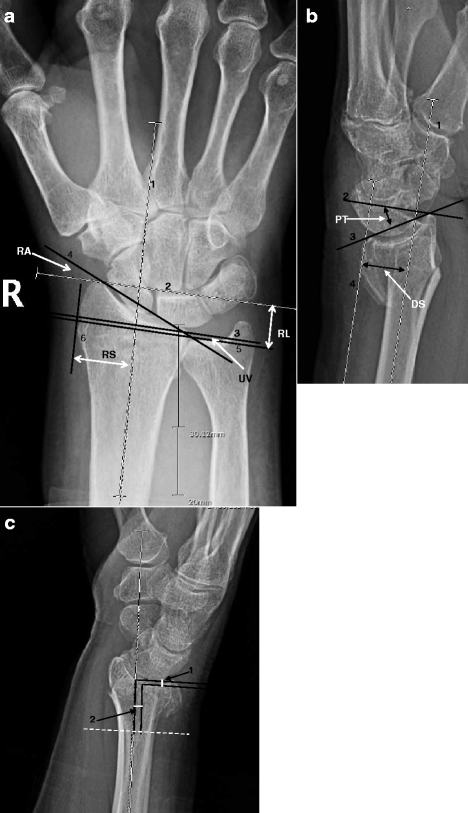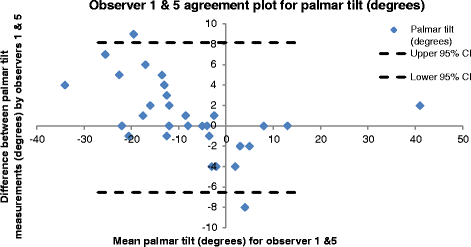Reliability of radiographic measurements for acute distal radius fractures
- PMID: 27443373
- PMCID: PMC4957423
- DOI: 10.1186/s12880-016-0147-7
Reliability of radiographic measurements for acute distal radius fractures
Abstract
Background: The management of distal radial fractures is guided by the interpretation of radiographic findings. The aim of this investigation was to determine the intra- and inter-observer reliability of eight traditionally reported anatomic radiographic parameters in adults with an acute distal radius fracture.
Methods: Five observers participated. All were routinely involved in making treatment decisions based on distal radius fracture radiographs. Observers performed independent repeated measurements on 30 radiographs for eight anatomical parameters: dorsal shift (mm), intra-articular gap (mm), intra-articular step (mm), palmar tilt (degrees), radial angle (degrees), radial height (mm), radial shift (mm), ulnar variance (mm). Intraclass correlation coefficients (ICCs) and the magnitude of retest errors were calculated.
Results: Measurement reliability was summarised as high (ICC > 0.80), moderate (0.60-0.80) or low (<0.60). Intra-observer reliability was high for dorsal shift and palmar tilt; moderate for radial angle, radial height, ulnar variance and radial shift; and low for intra-articular gap and step. Inter-observer reliability was high for palmar tilt; moderate for dorsal shift, ulnar variance, radial angle and radial height; and low for radial shift, intra-articular gap and step. Error magnitude (95 % confidence interval) was within 1-2 mm for intra-articular gap and step, 2-4 mm for ulnar variance, 4-6 mm for radial shift, dorsal shift and radial height, and 6-8° for radial angle and palmar tilt.
Conclusions: Based on previous reports of critical values for palmar tilt, ulnar variance and radial angle, error margins appear small enough for measurements to be useful in guiding treatment decisions. Our findings indicate that clinicians cannot reliably measure values ≤1 mm for intra-articular gap and step when interpreting radiographic parameters using the standardised methods investigated in this study. As a guide for treatment selection, palmar tilt, ulnar variance and radial angle measurements may be useful, but intra-articular gap and step appear unreliable.
Keywords: Distal radius fracture; Radiographs; Reliability.
Figures



Similar articles
-
Reliability and clinical importance of teardrop angle measurement in intra-articular distal radius fracture.J Hand Surg Am. 2012 Mar;37(3):454-9. doi: 10.1016/j.jhsa.2011.10.056. Epub 2012 Jan 30. J Hand Surg Am. 2012. PMID: 22284748
-
Are radiographic measurements of the displacement of a distal radial fracture reliable and reproducible?Bone Joint J. 2016 Aug;98-B(8):1069-73. doi: 10.1302/0301-620X.98B8.37469. Bone Joint J. 2016. PMID: 27482019
-
Is it really necessary to restore radial anatomic parameters after distal radius fractures?Injury. 2014 Dec;45 Suppl 6:S21-6. doi: 10.1016/j.injury.2014.10.018. Epub 2014 Oct 27. Injury. 2014. PMID: 25457314 Review.
-
Radial Reference Points for Measuring Palmar Tilt and Ulnar Variance on Lateral Wrist Radiographs.J Hand Surg Asian Pac Vol. 2020 Mar;25(1):95-103. doi: 10.1142/S2424835520500137. J Hand Surg Asian Pac Vol. 2020. PMID: 32000593
-
The use of dorsal distraction plating for severely comminuted distal radius fractures: A review and comparison to volar plate fixation.Injury. 2019 Jun;50 Suppl 1:S50-S55. doi: 10.1016/j.injury.2019.03.052. Epub 2019 Apr 6. Injury. 2019. PMID: 31040029 Review.
Cited by
-
Risk Factors for the Incidence of the Volar Lunate Facet Fragments in Distal Radius Fractures.J Wrist Surg. 2023 Jan 11;12(4):353-358. doi: 10.1055/s-0042-1760125. eCollection 2023 Aug. J Wrist Surg. 2023. PMID: 37564612 Free PMC article.
-
The effect of forearm rotation on radiographic measurements of the wrist: an experimental study using radiostereometric analyses on cadavers.Eur Radiol Exp. 2021 Apr 2;5(1):15. doi: 10.1186/s41747-021-00209-1. Eur Radiol Exp. 2021. PMID: 33796970 Free PMC article.
-
Association between imaging parameter changes and triangular fibrocartilage complex injury after distal radius fractures.J Orthop Surg Res. 2023 Dec 9;18(1):946. doi: 10.1186/s13018-023-04438-5. J Orthop Surg Res. 2023. PMID: 38071283 Free PMC article.
-
Testing a new method of osteosynthesis of forearm fractures in children; a prospective randomized controlled longitudinal study.J Child Orthop. 2022 Apr;16(2):88-97. doi: 10.1177/18632521221090406. Epub 2022 Apr 30. J Child Orthop. 2022. PMID: 35620127 Free PMC article.
-
Intra- and inter-observer agreement in distal radius fracture dislocation measurement of casting position.Acta Orthop. 2023 Jul 21;94:379-386. doi: 10.2340/17453674.2023.13707. Acta Orthop. 2023. PMID: 37493603 Free PMC article.
References
Publication types
MeSH terms
LinkOut - more resources
Full Text Sources
Other Literature Sources
Medical
Research Materials
Miscellaneous

